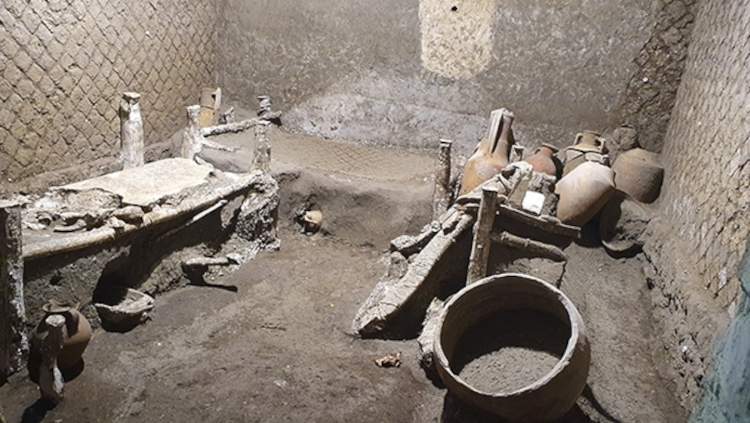Pompeii, at Civita Giuliana discovered a room possibly intended for slaves
At Civita Giuliana, in the suburban villa north of Pompeii in which excavations were begun in 2017 and where a four-wheeled ceremonial parade chariot in excellent condition was discovered in February 2021, a room has been discovered that is thought to have been used for slaves working in the villa.
The discovery took place not far from the portico where the ceremonial chariot was discovered, which is currently undergoing consolidation and restoration work-a room in good condition.
A wooden chest containing metal and fabric objects that were probably part of the horses’ harnesses, the helm of a chariot, and three wooden cots were found here. The latter consisted of a few worked wooden planks that could be assembled according to the height of the person using them: two about 1.70 meters long, while another was 1.40 meters long, which would suggest the height of a boy or child. The bedding of the beds consisted of ropes whose footprints are partially legible in the cinerite and above which were placed fabric blankets, also preserved as hollows in the ground. Under the cots were a few personal items, including amphorae rested to store private items, ceramic jugs and the “chamber pot.” The room was lit by a small window at the top and had no decorations on the walls.
In addition to serving as a dormitory, perhaps the room was also used as a storage room, as amphorae were also found crammed into the corners.
The excavation of the room is part of an activity that the Pompeii Archaeological Park is carrying out together with the Torre Annunziata prosecutor’s office.
“This is a window into the precarious reality of people who rarely appear in historical sources, written almost exclusively by men belonging to the elite, and who therefore risk remaining invisible in the great historical narratives,” said Archaeological Park director Gabriel Zuchtriegel. “It is a case where archaeology helps us discover a part of the ancient world that we know little about, but which is extremely important. What is striking is the narrowness and precariousness of this room, a cross between dormitory and storeroom of just 16 square meters, which we can now reconstruct thanks to the exceptional conditions of preservation created by the eruption of 79 AD.”
Ph.Credit Pompeii Archaeological Park
 |
| Pompeii, at Civita Giuliana discovered a room possibly intended for slaves |
Warning: the translation into English of the original Italian article was created using automatic tools. We undertake to review all articles, but we do not guarantee the total absence of inaccuracies in the translation due to the program. You can find the original by clicking on the ITA button. If you find any mistake,please contact us.




























